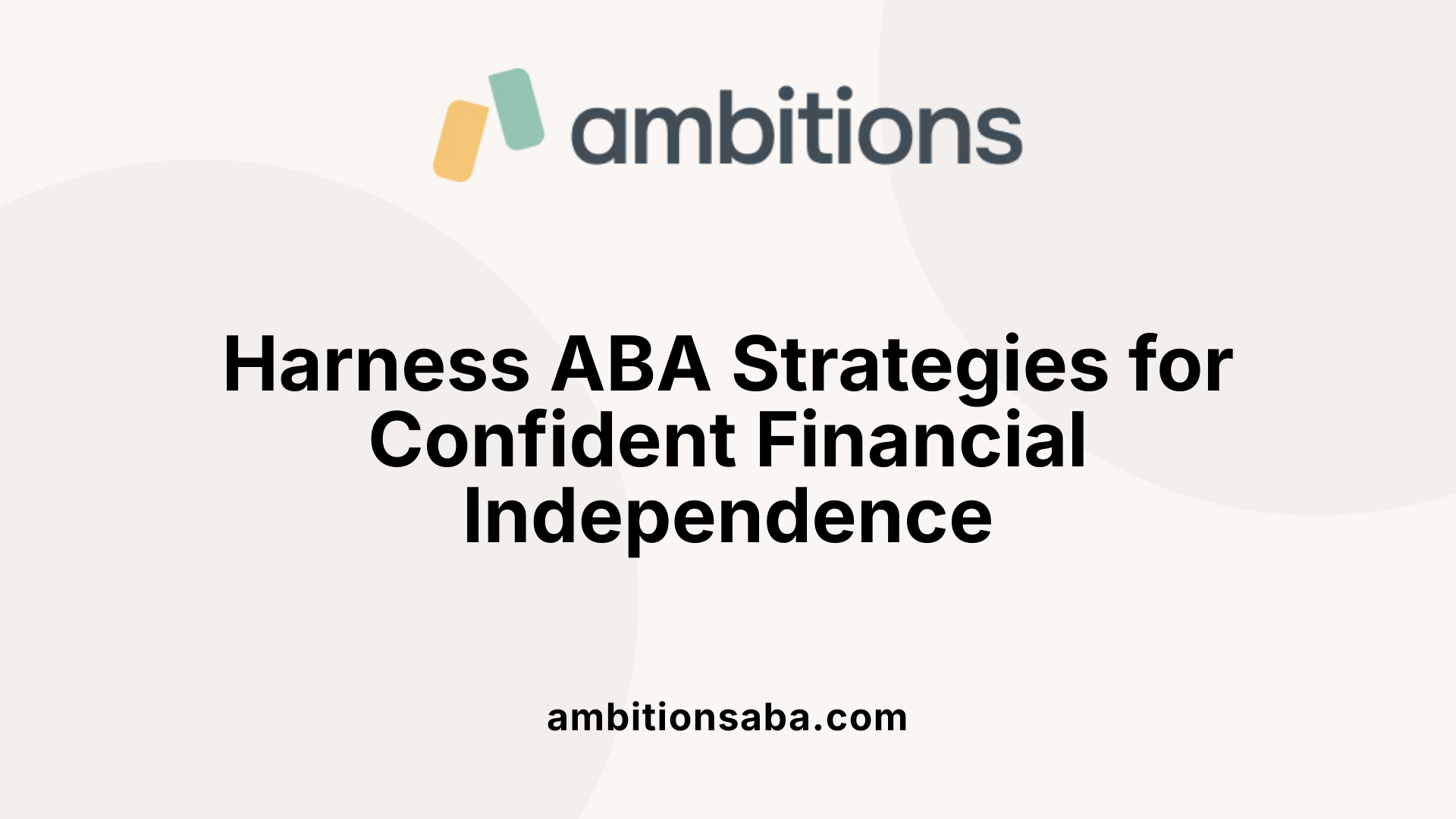Unraveling the Connection Between Cerebral Palsy and Autism: Myths and Facts
Unlocking Practical Money Skills with Applied Behavior Analysis
Teaching money skills is a vital component of fostering independence, especially for individuals with developmental disabilities such as autism. ABA approaches offer structured, engaging, and effective strategies to develop financial literacy from concrete concepts to complex money management behaviors. This article explores how ABA methodologies can be applied to teach practical monetary skills, ensuring their transfer to real-world situations and enhancing overall quality of life.
Understanding Skill Acquisition Programs in ABA

What are skill acquisition programs in ABA?
Skill acquisition programs in Applied Behavior Analysis (ABA) are structured teaching strategies aimed at helping individuals learn new skills and reduce problematic behaviors. These programs are tailored to address unique needs across various areas like communication, social skills, self-care, academics, and adaptive behaviors.
The core of these programs involves carefully planned interventions that break down complex skills into manageable steps. For example, teaching a child to count coins or make simple transactions uses specific activities and cues to promote mastery.
Assessment and continual data collection are essential components. Behavior analysts perform assessments such as functional behavior assessments to identify what influences behaviors and to determine appropriate teaching methods. Using data, they monitor progress closely and make necessary adjustments.
The ultimate goal of skill acquisition programs is to foster independence and improve the individual’s overall quality of life. They help clients acquire functional skills that are meaningful and applicable in everyday settings, whether in the classroom, at home, or in the community. By focusing on practical and socially significant skills, these programs aim to equip individuals with the tools needed for successful independent living and social participation.
Applying ABA Techniques to Teach Money and Financial Skills

How can ABA techniques be used to teach money and financial skills?
ABA, or Applied Behavior Analysis, provides structured and effective methods for teaching complex money management skills, especially to individuals with autism or special needs. One core strategy involves task analysis, which breaks down intricate financial behaviors—such as making change or creating a budget—into simple, manageable steps. This division allows learners to master each part before moving to the next.
Reinforcement is another critical component. Positive rewards, such as praise, tokens, or access to preferred activities, motivate students to perform financial tasks correctly and consistently. For example, giving verbal praise or earning tokens after successfully paying for an item encourages repeated independent performance.
Prompting techniques, including visual supports like money charts or step-by-step guides, physical assistance, or gestural cues, help learners complete tasks when they are initially learning. These prompts gradually fade as independence increases, promoting autonomous skills.
Errorless teaching methods are employed to reduce mistakes during practice. This approach involves providing prompts or cues that make correct responses more likely until the learner can perform the skill reliably on their own.
Generalization is emphasized by practicing money skills in natural settings such as grocery stores, mock stores, or community outings. This transfer of skills from controlled environments to real-world situations ensures learners can use their financial abilities confidently outside the classroom.
Incorporating technology, like budgeting apps and interactive financial literacy tools, further supports learning. These resources offer engaging, customizable lessons that reinforce skills such as saving, budgeting, and handling cash.
Altogether, ABA strategies—task analysis, reinforcement, prompting, errorless teaching, and generalization—form a comprehensive framework to develop practical money skills. These approaches foster independence, ensuring that individuals are prepared for everyday financial transactions and fostering greater confidence in real-world environments.
Teaching Complex Financial Skills with ABA Methods

What ABA methods are effective for teaching complex skills such as money management?
Applied Behavior Analysis (ABA) offers several well-established strategies to teach complex and multi-step skills like money management, especially for individuals with special needs. These include forward chaining, backward chaining, and the total task teaching approach.
Forward chaining involves teaching the first step of a task first, then gradually adding subsequent steps as mastery is achieved. For example, a student might first learn to identify coins before proceeding to counting and making transactions.
Backward chaining starts with the final step and works backwards through the task sequence. This approach ensures the learner experiences success at the end of the process, such as completing a purchase and receiving change.
Total task teaching involves teaching all steps of a task in the learning session, with prompts and fading assistance, allowing the student to practice every component at once. This method is particularly useful for helping students generalize skills across different settings and scenarios.
How do these methods support teaching money skills?
Using stimulus class formation, exclusion, and matching stimulus components, ABA techniques help individuals form associations between coins, bills, and their values. Role-playing activities, real-life shopping outings, and practice in community settings reinforce these skills.
Teacher-guided practice, with visual supports and step-by-step guides, helps break down complex tasks like saving, budgeting, and making change into manageable parts. Incorporating technology such as budgeting apps further enhances engagement and understanding.
Through targeted interventions employing these ABA methods, students develop independence and confidence in real-world financial transactions, preparing them for everyday life.
| ABA Method | Description | Application in Money Skills | Benefits |
|---|---|---|---|
| Forward Chaining | Teaching starting from the first step | Identifying coins, beginning to count | Builds confidence with early steps |
| Backward Chaining | Starting from the last step, working backwards | Receiving change and final transaction | Ensures successful completion, motivation |
| Total Task Teaching | Teaching all steps together with prompts | Complete shopping or budgeting task | Promotes overall skill transfer |
These strategies are most effective when incorporated into natural social interactions and practiced across multiple settings, supporting lasting skill development.
Activities and Strategies to Promote Money Management

How can role-playing shopping scenarios help teach money management?
Role-playing shopping scenarios serve as a practical way to teach individuals, especially those with special needs, how to navigate financial transactions in real-world situations. During these activities, learners practice selecting items, counting coins or bills, and paying the cashier. This hands-on approach reinforces understanding of money value, improves skills in handling money, and helps students become comfortable with transactions. Setting up mock stores or grocery store outings provides an engaging environment where students can apply these skills in a controlled, supportive setting.
How are visual aids and money templates used in teaching money skills?
Visual supports are essential tools in making abstract money concepts concrete. Charts showing different coins and bills, pictorial expense lists, and step-by-step guides help visual learners grasp the relationship between denominations and their uses. Money templates, such as fill-in-the-blank checklists or visual counting strips, assist students in organizing their money and understanding how to allocate funds. These visuals simplify complex tasks and foster independent decision-making.
Why is practicing saving and budgeting important, and how is it implemented?
Practicing saving and budgeting teaches valuable skills like goal setting, delayed gratification, and financial planning. Activities may include creating simple budgets for classroom projects or personal goals and using reinforcement through reward stores or incentives. Breaking these tasks into manageable steps, such as identifying income, necessary expenses, and savings, helps individuals learn each component thoroughly. Guided practice in real-life settings, like community outings, further reinforces these skills for practical application.
How does breaking down complex concepts support financial learning?
Financial skills—like saving, budgeting, and understanding interest—can be overwhelming if presented all at once. Breaking down these concepts into smaller, manageable parts makes learning easier. For example, teaching saving as “putting money aside” first, then gradually introducing the idea of budgeting, helps learners build confidence and retain information. This incremental approach is reinforced with feedback, visual supports, and ongoing practice, ensuring that skills are learned thoroughly and transfer to real-world situations.
What ABA strategies enhance effective money management learning?
ABA strategies such as role-playing, natural environment practice, and the use of scripts help embed money skills into daily routines. Role plays allow learners to practice social interactions during transactions, like asking for the total or giving change. Practicing these skills in natural settings, such as stores or restaurants, promotes generalization. Additionally, setting specific goals, providing reinforcement, and offering guidance during practice when unsupervised support mastery helps in developing independence. Technology like budgeting apps can offer interactive, customizable learning modules that further reinforce these skills.
| Strategy | Description | Benefits |
|---|---|---|
| Role-playing shopping scenarios | Practicing transactions in simulated settings | Builds confidence, improves calculation and social skills |
| Visual aids and templates | Charts, step-by-step guides, money recognition materials | Enhances understanding, supports independent use |
| Saving and budgeting exercises | Creating and practicing with real or simulated budgets | Develops goal setting, planning, and delayed gratification skills |
| Breaking down complex concepts | Teaching in small steps with visual and practical supports | Facilitates retention and reduces overwhelm |
By combining these engaging activities and structured strategies, educators can effectively teach money management skills that promote independence and real-world readiness for individuals with diverse learning needs.
Utilizing Natural Environment Practice and Social Skills Training
How does practicing money skills in natural settings benefit learners?
Engaging students in real-world shopping and community activities significantly enhances their ability to transfer learned money management skills into everyday life. Practicing in authentic settings like grocery stores, mock shops, or community outings allows students to apply their skills in realistic contexts, which boosts confidence and retention.
These practical experiences help learners understand the social and practical aspects of transactions, such as handling money, asking for prices, and receiving change. With guided support, students can practice social responses like requesting the total amount, giving money correctly, or seeking assistance if they lack sufficient funds.
Using scripts and role-playing scenarios for challenging social situations prepares students for common interactions during purchases. This targeted approach ensures they understand appropriate behaviors when faced with questions such as 'Do you have exact change?' or needing help. Incorporating these routines into multiple settings promotes generalization, allowing learners to effectively navigate various environments beyond the classroom.
Overall, natural environment practice enriches the learning experience. It fosters independence, enhances social skills, and firmly establishes functional money management behaviors that students can carry into their daily routines.
Supporting Money Skills Development with Visual and Technological Aids

How do visual supports enhance understanding of financial concepts?
Visual aids such as money charts, pictorial expense guides, and step-by-step instructions play a crucial role in helping students, especially those with visual learning preferences, grasp financial concepts more effectively. These tools break down abstract ideas—like budgeting or saving—into clear, manageable visuals that learners can easily interpret.
What role do budgeting apps and interactive educational tools play?
Technology offers engaging ways to teach money management. Budgeting apps and specialized educational applications provide interactive lessons that adapt to individual learning paces. These tools are particularly useful for practicing real-world financial tasks, such as tracking expenses or understanding banking features, in a safe, controlled environment.
How can visual supports be integrated into teaching strategies?
Incorporating visual supports involves using money charts to identify coins and bills, pictorial guides for expenses, and step-by-step procedures for transactions. This visual reinforcement makes it easier for learners to internalize procedures like counting change, recording expenses, and planning a basic budget. Repeated practice with these tools builds confidence and promotes independence in financial skills.
Fostering Financial Independence with ABA
ABA approaches to teaching money skills emphasize functional, engaging, and real-life applicable strategies. Through task analysis, reinforcement, natural environment practice, and visual supports, individuals—particularly those with autism—can acquire essential financial behaviors. Implementing these ABA methods not only develops competency in handling cash, making purchases, and budgeting but also significantly boosts independence and confidence. As these skills transfer seamlessly across settings, learners are better prepared for real-world financial challenges, ultimately promoting their lifelong financial autonomy.
References
- How to Make Teaching Money Engaging and Functional
- Helping Individuals with Autism Learn Money Management Skills
- Teaching money skills through stimulus class formation, exclusion ...
- Tip of the Week: Teaching Money Skills to Students with Autism in ...
- [PDF] ABA-101-Handouts-The-Autism-Helper
- Question retrieval with user intent - ACM Digital Library
- From Intent Discovery to Recognition with Topic Modeling ... - arXiv
- How To Implement Intent Classification In NLP [7 ML & DL Models]

